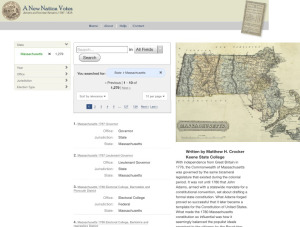Part 1: Students’ Access to Sources by Rachel Herrmann
Let me preface this post by saying that I’d hesitate to call myself a digital humanist; I don’t code or map or mine texts. As Lincoln Mullen pointed out a while back, however, digital practices exist on a spectrum. There are some things I do for my own research and in the classroom—tweeting, running my department’s social media accounts, using Amazon’s “Look Inside” feature to chase up a footnote so as not to use up one of my precious Interlibrary Loan requests, and of course, blogging for The Junto—that digital humanists also do. These approaches have been helpful in my teaching for three problems related to access to sources.
Part 2:Pitching Courses for Non-Majors by Jessica Parr
Like most historians, my approach to teaching digital history is a function of the university and student population I teach. My university is small, STEM-centered, and opportunities for cross-registration are encouraged. We try to make lower and mid-level courses accessible to majors whenever possible. The university has recently undergone an external evaluation that has also encouraged opportunities for experiential learning. In addition to teaching as an adjunct, I also work part time for the university as a coordinator for a new minor we are creating in public history. I have taught digital history as a special topic on a few separate occasions. As part of this curriculum development, we are aiming to create a digital humanities course that is more permanent part of the curriculum. The course is presently taught as a mid-level course with no pre-requisites, and is open to all majors. While approximately half of my enrollees tend to be either History or Humanities majors, we have also seen a number of enrollees from Computer Science, Communication Arts, and Business. At least some of them will have taken one of our survey courses, but they may not have much History background beyond high school.
Part 3: Technical Knowledge by Joseph M. Adelman
I’m always both impressed and intimidated when I see a digital history project pop up in my social media channels. Faculty are doing some amazing work getting students to create work using sophisticated software, apps, and other programs. They create websites, run statistical analyses, markup text using TEI … and I have no idea how to replicate it in my classroom either for myself or my students. To be fair, I have not yet taught a course on digital history specifically (nor do I plan to in the near future). So I’d like to focus instead on some practical thoughts about integrated digital history methods into the classroom in topical upper-level courses.
